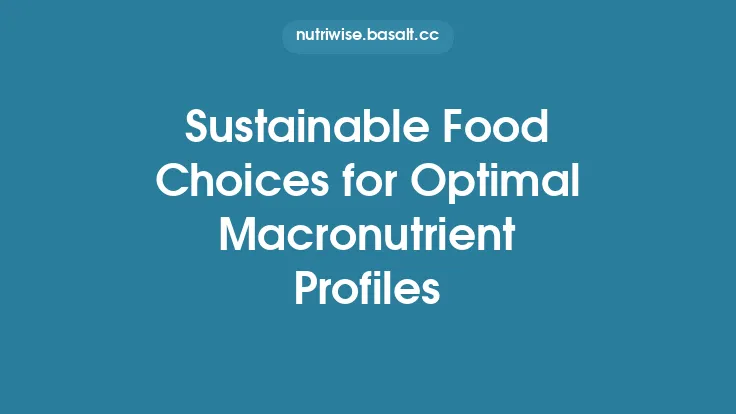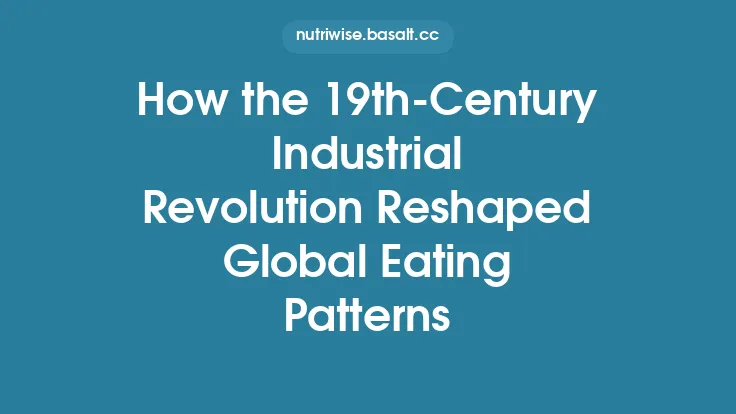The modern food system is often portrayed as a monolithic chain that moves a handful of staple crops from field to fork. Yet the choices we make at the dinner table have far‑reaching consequences for the planet’s biological richness. When consumers deliberately incorporate a broad spectrum of foods—different grains, legumes, fruits, vegetables, nuts, and responsibly sourced animal products—they create market signals that encourage producers to cultivate a wider array of species and varieties. This diversification at the production level, in turn, sustains the complex web of life that underpins global ecosystems. Below, we explore the mechanisms by which diverse food choices reinforce biodiversity, the economic and policy levers that amplify these effects, and practical pathways for individuals and institutions to contribute to a more resilient biosphere.
The Ecological Rationale for Dietary Diversity
Reducing Homogenization of Agro‑ecosystems
Agricultural homogenization occurs when a limited set of species dominates cultivated land. Such uniformity simplifies management but erodes the genetic and species diversity that buffers ecosystems against pests, diseases, and climate variability. By demanding a wider menu of foods, consumers compel growers to expand the portfolio of cultivated species, thereby re‑introducing genetic heterogeneity into the landscape. This heterogeneity enhances ecosystem functions such as nutrient cycling, soil structure maintenance, and water regulation.
Enhancing Functional Redundancy
Functional redundancy refers to the presence of multiple species that perform similar ecological roles (e.g., nitrogen fixation, pollination, pest suppression). When diets incorporate a variety of legumes, for instance, farmers are incentivized to grow different nitrogen‑fixing species (e.g., soybeans, lentils, chickpeas, cowpeas). The coexistence of these legumes reduces reliance on any single species for soil fertility, making agro‑ecosystems more robust to shocks.
Mitigating Pest and Disease Pressure
Monocultures are especially vulnerable to outbreaks because a pathogen that can infect one plant can rapidly spread across an entire field. Diverse cropping systems, driven by diversified consumer demand, interrupt the continuity of host plants, creating spatial and temporal barriers that limit pathogen proliferation. This “dilution effect” reduces the need for chemical interventions, which can have downstream impacts on non‑target organisms and water quality.
Supporting Habitat Complexity
Different crops create distinct microhabitats. For example, tall grain stalks provide shelter for ground‑dwelling arthropods, while low‑lying legumes offer foraging grounds for beetles and spiders. A mosaic of crops, encouraged by varied dietary preferences, generates a patchwork of habitats that sustains a broader spectrum of wildlife, from soil microbes to vertebrates.
Consumer Demand as a Driver of Agricultural Heterogeneity
Market Signals and Crop Choice
Retail data consistently show that when consumers purchase a broader range of products, growers respond by allocating more acreage to those crops. This response is mediated through price signals: higher demand raises the market price of less common foods, making their cultivation economically viable. Over time, this can shift the composition of regional agricultural portfolios away from a few dominant staples toward a more balanced mix.
Seasonal and Regional Diversity
When consumers value seasonal produce and regional specialties, they encourage farmers to grow crops suited to local climates and soils rather than relying on imported, uniform varieties. This localized production supports native plant species and preserves the ecological integrity of regional ecosystems.
Culinary Innovation and Food Culture
The rise of global cuisines and fusion cooking has expanded the palate of many diners. As restaurants and home cooks experiment with ingredients such as millet, amaranth, or lesser‑known fruit varieties, supply chains adapt to meet these new preferences. This cultural diffusion fuels agricultural diversification at scale.
Supply Chain Implications of Varied Food Choices
Diversified Sourcing Networks
A supply chain that sources from multiple producers reduces dependence on a single source or region. This diversification spreads risk and encourages small‑holder farms to enter the market, as they can find niche buyers for their specialized crops. The resulting network of producers contributes to a more heterogeneous agricultural landscape.
Storage and Distribution Infrastructure
Handling a wider array of foods necessitates improvements in post‑harvest technology, such as temperature‑controlled storage for perishable items and specialized packaging for delicate produce. Investment in such infrastructure benefits all producers, including those cultivating biodiversity‑rich crops that might otherwise be excluded due to logistical constraints.
Traceability and Transparency
Consumers seeking diverse foods often demand information about origin, farming practices, and sustainability credentials. Traceability systems (e.g., blockchain, QR codes) enable producers to certify that their crops contribute to biodiversity goals, creating a feedback loop that reinforces responsible production.
Economic Incentives for Biodiversity‑Friendly Production
Premium Pricing and Niche Markets
Products that are marketed as “biodiversity‑supporting” can command price premiums. This financial incentive encourages farmers to allocate land to crops that are less common but ecologically valuable, such as under‑utilized grain species that improve soil health.
Agri‑environmental Payments
Governments and NGOs increasingly offer direct payments to farmers who adopt practices that enhance biodiversity, such as maintaining field margins, rotating crops, or planting cover crops. When consumer demand aligns with these schemes, the financial flow from market to farm is amplified.
Cooperative Models and Collective Bargaining
Producer cooperatives can aggregate the output of many small farms, providing a reliable supply of diverse foods to larger retailers. By pooling resources, cooperatives can invest in biodiversity‑friendly practices that would be unaffordable for individual farms.
Policy Frameworks Supporting Diverse Diets
Dietary Guidelines Incorporating Biodiversity Metrics
National dietary guidelines that explicitly reference the importance of consuming a variety of plant and animal foods can shape public perception and purchasing behavior. When guidelines are linked to biodiversity outcomes, they provide a policy backbone for educational campaigns.
Subsidy Reforms
Redirecting subsidies away from a narrow set of staple crops toward a broader range of species can level the playing field for diverse producers. Such reforms can be calibrated to avoid market distortions while encouraging ecological benefits.
Trade Policies Favoring Sustainable Imports
Tariff structures and import standards that reward biodiversity‑positive production (e.g., certifications for low‑impact farming) can stimulate the global flow of diverse foods, supporting producers in biodiversity‑rich regions.
Illustrative Case Studies
Multi‑Crop Systems in the Andean Highlands
In parts of the Andes, smallholder farmers cultivate a suite of tubers (potato, oca, mashua) alongside legumes and quinoa. Consumer interest in Andean superfoods has expanded export markets, prompting farmers to maintain this polyculture. The resulting landscape supports a high density of soil microbes and invertebrates, contributing to carbon sequestration and erosion control.
Urban Community Gardens in European Cities
Cities such as Copenhagen and Barcelona have embraced community gardens that grow a wide variety of vegetables, herbs, and fruit trees. Residents’ demand for fresh, diverse produce drives the allocation of municipal land to these gardens. The resulting green spaces provide habitats for pollinators, birds, and beneficial insects, enhancing urban biodiversity.
Diversified Poultry Production in Southeast Asia
In response to rising consumer interest in heritage and specialty eggs, small-scale poultry farms have introduced multiple chicken breeds and alternative protein sources (e.g., insects, algae) into feed rations. This diversification reduces reliance on a single feed crop, lowers the risk of disease outbreaks, and supports a broader range of feed‑producing plant species.
Future Directions and Recommendations
- Integrate Biodiversity Metrics into Food Labeling – Develop standardized labels that convey the biodiversity impact of a product, enabling consumers to make informed choices without requiring deep technical knowledge.
- Expand Consumer Education Programs – Partnerships between NGOs, academic institutions, and retailers can create curricula that explain how dietary variety translates into ecological benefits, fostering long‑term behavioral change.
- Invest in Research on Crop Compatibility – Agronomic studies that identify optimal crop combinations for specific climates can guide farmers in designing diversified planting schemes that maximize both yield and biodiversity.
- Strengthen Data Infrastructure – Comprehensive databases linking consumption patterns to agricultural outcomes will allow policymakers to assess the effectiveness of diversity‑focused interventions and adjust strategies accordingly.
- Promote Cross‑Sector Collaboration – Aligning the objectives of nutritionists, ecologists, economists, and supply‑chain managers ensures that initiatives to diversify diets are coherent, scalable, and resilient.
By consciously expanding the spectrum of foods we consume, we generate a cascade of ecological, economic, and social benefits that reinforce the planet’s biological wealth. Diverse food choices are not merely a culinary preference; they are a strategic lever for preserving the intricate tapestry of life that sustains humanity. Embracing this principle at the individual, community, and policy levels offers a pragmatic pathway toward a more biodiverse and sustainable future.





